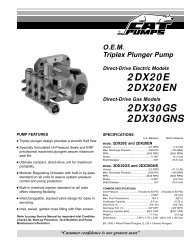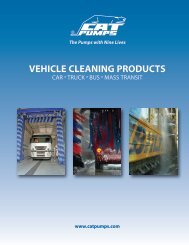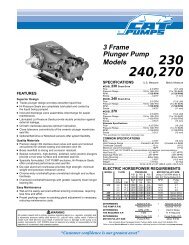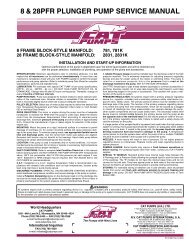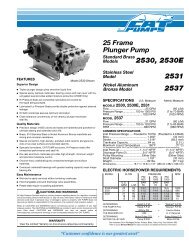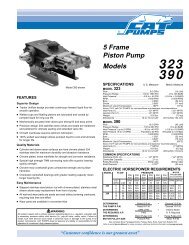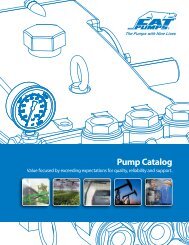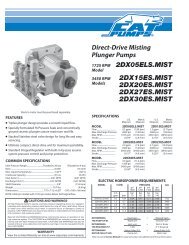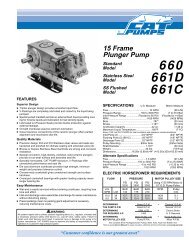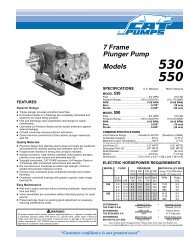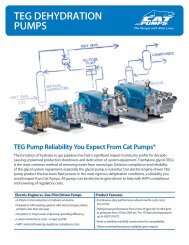Pump service manual for 1DX, 2DX, 3DX, 3DNX, 3SP ... - Cat Pumps
Pump service manual for 1DX, 2DX, 3DX, 3DNX, 3SP ... - Cat Pumps
Pump service manual for 1DX, 2DX, 3DX, 3DNX, 3SP ... - Cat Pumps
Create successful ePaper yourself
Turn your PDF publications into a flip-book with our unique Google optimized e-Paper software.
DIAGNOSIS AND MAINTENANCE<br />
One of the most important steps in a high pressure system is to establish a regular maintenance program. This will vary slightly with each<br />
system and is determined by various elements such as the duty cycle, the liquid being pumped, the actual specifications vs rated specifications<br />
of the pump, the ambient conditions, the inlet conditions and the accessories in the system. A careful review of the necessary inlet conditions<br />
and protection devices required be<strong>for</strong>e the system is installed will eliminate many potential problems.<br />
CAT PUMPS are very easy pumps to <strong>service</strong> and require far less frequent <strong>service</strong> than most pumps. Typically, only common tools are required,<br />
making in-field <strong>service</strong> convenient, however, there are a few custom tools, special to certain models, that do simplify the process. This <strong>service</strong><br />
<strong>manual</strong> is designed to assist you with the disassembly and reassembly of your pump. The following guide will assist in determining the cause<br />
and remedy to various operating conditions. You can also review our FAQ or SERVICE sections on our WEB SITE <strong>for</strong> more facts or contact CAT<br />
PUMPS directly.<br />
PROBLEM PROBABLE CAUSE SOLUTION<br />
Low pressure •Worn nozzle. •Replace with properly sized nozzle.<br />
•Air leak in inlet plumbing. •Tighten fittings and hoses. Use PTFE liquid or tape.<br />
•Pressure gauge inoperative or not registering accurately. •Check with new gauge. Replace worn or damaged gauge.<br />
•Relief valve stuck, partially plugged or improperly adjusted. •Clean/adjust relief valve. Replace worn seats/valves and o-rings.<br />
•Inlet suction strainer (filter) clogged or improperly sized. •Clean filter. Use adequate size filter. Check more frequently.<br />
•Abrasives in pumped liquid. •Install proper filter.<br />
•Leaky discharge hose. •Replace discharge hose with proper rating <strong>for</strong> system.<br />
•Inadequate liquid supply. •Pressurize inlet and install C.A.T.<br />
•Severe cavitation. •Check inlet conditions.<br />
•Worn seals. •Install new seal kit. Increase frequency of <strong>service</strong>.<br />
•Worn or dirty inlet/discharge valves. •Clean inlet/discharge valves or install new valve kit.<br />
Pulsation •Faulty Pulsation Dampener. •Check precharge. If low, recharge, or install a new dampener.<br />
•Foreign material trapped in inlet/discharge valves. •Clean inlet/discharge valves or install new valve kit.<br />
Water leak<br />
•Under the manifold •Worn V-Packing, Hi-Pressure or Lo-Pressure Seals. •Install new seal kit. Increase frequency of <strong>service</strong>.<br />
•Worn adapter o-rings. •Install new o-rings.<br />
•Into the crankcase •Excessive wear to seals. •Install new seal kit. Increase frequency of <strong>service</strong>.<br />
Knocking noise<br />
•Inlet supply •Inadequate inlet liquid supply. •Check liquid supply. Increase line size, pressurize or install C.A.T.<br />
•Bearing •Broken or worn bearing. •Replace bearing.<br />
Oil leak<br />
•Crankcase oil seals. •Worn crankcase oil seals. •Replace crankcase oil seals.<br />
•Crankshaft oil seals and o-rings. •Worn crankshaft oil seals or o-rings on bearing cover. •Remove bearing cover and replace o-rings and/or oil seals.<br />
•Drain plug •Loose drain plug or worn drain plug o-ring. •Tighten drain plug or replace o-ring.<br />
•Bubble gauge •Loose bubble gauge or worn bubble gauge gasket. •Tighten bubble gauge or replace gasket.<br />
•Bearing cover •Loose bearing cover or worn bearing cover o-ring. •Tighten bearing cover or replace o-ring.<br />
•Filler cap •Loose filler cap or excessive oil in crankcase. •Tighten filler cap. Fill crankcase to specified capacity.<br />
<strong>Pump</strong> runs extremely rough<br />
•Inlet conditions •Restricted inlet or air entering the inlet plumbing •Correct inlet size plumbing. Check <strong>for</strong> air tight seal.<br />
•<strong>Pump</strong> valves •Stuck inlet/discharge valves. •Clean out <strong>for</strong>eign material or install new valve kit.<br />
•<strong>Pump</strong> seals •Leaking V-Packing, Hi-Pressure or Lo-Pressure seals. •Install new seal kit. Increase frequency of <strong>service</strong>.<br />
Premature seal failure •Scored plungers. •Replace plungers.<br />
•Over pressure to inlet manifold. •Reduce inlet pressure per specifications.<br />
•Abrasive material in the liquid being pumped. •Install proper filtration at pump inlet and clean regularly.<br />
•Excessive pressure and/or temperature of pumped liquid. •Check pressure and inlet liquid temperature.<br />
•Running pump dry. •DO NOT RUN PUMP WITHOUT LIQUID.<br />
•Starving pump of adequate liquid. •Increase hose one size larger than inlet port size. Pressurize and<br />
install C.A.T.<br />
•Eroded manifold. •Replace manifold. Check liquid compatibility.



